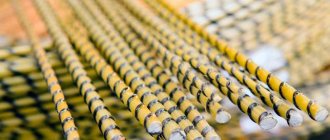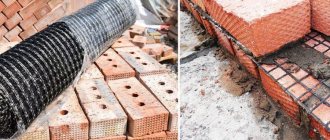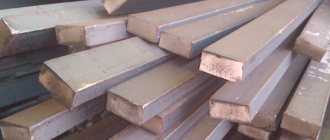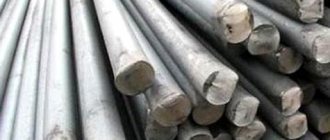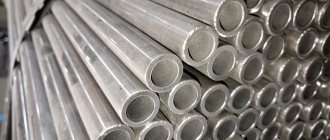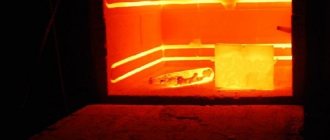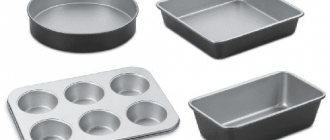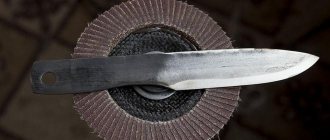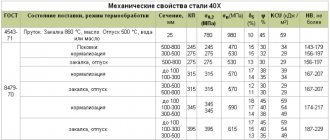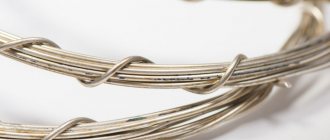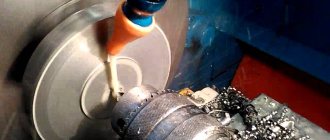Construction experts date the invention of composite reinforcement to the 60s of the last century. During this period, active research into its properties began in the USA and the Soviet Union.
However, despite its fairly advanced age, this material is still unfamiliar to most developers. This article will help you fill the knowledge gap about fiberglass reinforcement, its properties, advantages and disadvantages.
In passing, we note that this material is very controversial. Manufacturers praise it in every possible way, but practical builders treat it with distrust. Ordinary citizens look at both of them, not knowing who to believe.
What is composite reinforcement, how is it produced and where is it used?
Briefly, the structure of composite reinforcement can be described as “fiber in plastic.” Its basis is tear-resistant threads made of carbon, glass or basalt. The rigidity of the composite rod is given by the epoxy resin that envelops the fibers.
For better adhesion to concrete, a thin cord is wound around the rods. It is made of the same material as the main rod. The cord creates a helical relief, like a steel one. The epoxy resin hardens in a drying chamber. At the exit from it, the composite reinforcement is slightly pulled out and cut. Some manufacturers sprinkle plastic rods with sand before the polymer hardens to improve adhesion to concrete in smooth areas.
The scope of application of fiberglass reinforcement cannot be called very wide. It is used as flexible connections between the facade cladding and the load-bearing wall, and is also placed in road slabs and tank formwork. In frames that reinforce strip foundations and concrete floors, plastic reinforcement is not used so often.
It is not recommended to install composite rods in floor slabs, lintels and other tensile structures. The reason is the increased flexibility of this material.
Production technology
Despite many advantages, the production of composite reinforcement is a material-intensive process. It consists of a number of stages. First, the fibers are dipped into a polymer resin, which hardens the material. This is how roving is obtained. It is directed into a speciation-forming, high-strength mold, through which a rod of the required size is formed. The starting material undergoes a polymerization stage, heated to specified temperatures. To add ribbing, the profile is attached. The base with the wound profile is sent to the drying room, in which partial polymerization of the resin is performed. In another section of the drying room, an unwinding device removes the relief-forming wire from the base. The resulting rod is stretched to the specified parameters and cut into equal parts using a saw, folding it in a place for finished products.
Physical properties of composite reinforcement
The elastic modulus of the polymer composite is significantly lower than that of steel (from 60 to 130 versus 200 GPa). This means that where the metal comes into play, protecting the concrete from cracking, the plastic still continues to bend. The tensile strength of a fiberglass rod is 2.5 times higher than that of a steel rod.
The main strength parameters of composite reinforcement are contained in table No. 4 GOST 31938-2012
Here we see the main classes of composite material: ASK (fiberglass composite), ABK (basalt fiber), AUK (carbon), AAK (aramidocomposite) and ACC (combined - glass + basalt).
The least durable, but the cheapest - fiberglass reinforcement and basalt composite. The most reliable and at the same time the most expensive material is made based on carbon fiber (ACF).
We will return to the strength properties of the material when we compare it with metal.
In the meantime, let's look at other characteristics of this material:
- The positive qualities of the composite include its chemical inertness. It is not afraid of corrosion and exposure to aggressive substances (alkaline environment of concrete, sea water, road chemicals and acids).
- The weight of plastic fittings is 3-4 times less than steel. This saves on transportation.
- The low thermal conductivity of the material improves the energy-saving characteristics of the structure (no cold bridges).
- Composite reinforcement does not conduct electricity. In structures where it is used, there are no electrical short circuits or stray currents.
- Composite plastic is magnetically inert and radio transparent. This allows it to be used in the construction of structures where the factor of shielding electromagnetic waves must be excluded.
You cannot bend a fiberglass rod at 90 degrees at a construction site.
Disadvantages of composite reinforcement:
- Inability to bend with a small radius under construction conditions. The bent rod must be ordered in advance from the manufacturer.
- Inability to weld the frame (a relative minus, since even for steel reinforcement the best connection method is knitting, not welding).
- Low heat resistance. In case of strong heating and fire, a concrete structure reinforced with composite rods is destroyed. Fiberglass is not afraid of high temperatures, but the plastic that binds it loses strength when heated above +200 C.
- Aging. A common disadvantage of all polymers. Non-metallic fittings are no exception. Its manufacturers overestimate its service life to 80-100 years.
Knitting with plastic clamps or steel wire is the only possible method of assembling the frame
Which reinforcement is better, metal or fiberglass?
One of the main arguments given in favor of fiberglass reinforcement when compared with metal reinforcement is its lower price. However, if you look at the price tags of metal warehouses, you will see that this is not so. The cost of metal is on average 20-25% lower than the composite.
The reason for the confusion is that plastic sellers take into account the so-called “equivalent” diameter. The logic here is this: non-metallic reinforcement is tensile stronger than construction steel. Therefore, a polymer rod with a smaller diameter will withstand the same load as thicker steel reinforcement. Based on this, the conclusion is drawn: less plastic is needed to reinforce a structure than metal. This is where the “lower” price comes from.
For a reasoned comparison of a composite with metal, a regulatory document is needed. Today such guidance already exists. This is Appendix “L” to the order of the Ministry of Construction of Russia No. 493/pr dated 07/08. 2016
In paragraph L.2.3. obscure for ordinary developers, but very interesting for professionals, contains two reduction factors for all types of composite reinforcement.
For example, consider the most common fiberglass (FRP):
- Under continuous load, its tensile strength should be multiplied by 0.3. That is, instead of 800 MPa we get 240 MPa (800x0.3=240).
- If the structure operates outdoors, then the result obtained must be multiplied by another 0.7 (240 MPa x 0.7 = 168 MPa).
Table with reduction coefficient for composite reinforcement
Table with coefficients taking into account operating conditions
Further, as required by the standard, the resulting 168 MPa must be divided by a safety factor (safety factor) equal to 1.5. As a result, we get 112 MPa.
Now you can correctly compare the strength of plastic reinforcement with metal. For example, let's take construction steel grade A500. Its ultimate tensile strength, taking into account the safety factor, is 378 MPa. For the fiberglass composite, we obtained only 112 MPa.
Our small study is clearly illustrated by a table of real, and not theoretical, equal-strength replacement of steel reinforcement with composite reinforcement. It can be used when choosing and purchasing.
Having looked at this table, it is easy to notice that for plastic to be an equivalent replacement for metal, not less, but more metal is required. Only the most expensive carbon fiber material (CF) is superior to steel of equal diameter.
Business prospects
All of the above speaks of great prospects for such a business as the production of composite reinforcement, that is, fiberglass for construction needs. The entrepreneur who organized such production is unlikely to wish it; his enterprise, if the business is properly organized, is doomed to success. The most important thing is not to miss out, to occupy your niche before someone else takes it, because so far the competition in this area is not significant.
Organizing the production of such building material as fiberglass reinforcement is quite difficult. Significant initial investment and knowledge in this area are required. For an entrepreneur who does not have a lot of money and is not very familiar with this kind of business, it is better not to torture him.
Opening such an enterprise requires serious capital investment. Before investing money in a given business, it is worth carefully studying the designated area of industry, calculating the prospects of such an enterprise in your region, and exploring possible markets for the products. If the self-sufficiency of the enterprise according to the business plan is more than a year, it means that this region is not suitable for this business, it is necessary to open an enterprise in another region of the country that is more favorable for the development of this activity.
Construction stores, wholesale warehouses of building materials, and supermarkets can be considered as distribution channels. It is advisable that supply contracts with these enterprises be concluded in advance, even at the planning stage. For advertising purposes, as well as for image, it is recommended to create a web resource for the enterprise, through which you can organize the sale of products and receive orders from wholesale and retail customers. It is necessary to fill the site with such content as a detailed description of the fiberglass products produced for construction needs, and to the description add retail and wholesale costs, delivery terms, etc.
How to start the production of fittings?
Initially, an entrepreneur who decides to implement such a business project will need premises for the installation of a production line. The premises for such high-tech production must meet certain criteria, that is, organizing a workshop in a barn will not work.
The length of the room must be more than 26 meters, the ceilings must have a height of more than 3 meters, the floor where industrial equipment will be installed should not have a level difference of more than 4 centimeters. The workshop space must be connected to a heating and ventilation system. It must be possible to maintain a temperature in it of at least 15 degrees. You will also need storage space. We are talking about a spacious room that can accommodate the two-month production rate of the enterprise.
Equipment and personnel
Selecting and purchasing a production line is a responsible matter. The average cost of a complete set of industrial equipment for the production of composite reinforcement costs 35-40 thousand dollars. Such a kit usually includes the machines themselves, belts, ovens, that is, more than ten items.
The production technology for fiberglass reinforcement is not complicated; the fiberglass is processed with a special resin and then fed to a machine, which produces rods of the diameter specified by the master. These blanks undergo a polymerization process in special ovens, and finally a final coating is applied to them. Production technology depends on the specific equipment used and the purpose of the fittings.
It is worth recruiting production personnel only after industrial equipment has been purchased, installed, and adjusted. It is better to give preference to people who have a technical, engineering education and experience working with similar equipment. Typically, this kind of enterprise operates around the clock, that is, people work there in three shifts, that is, 2-3 production line operators will be required for each shift.
Range and price of composite reinforcement
The most in demand at construction sites is fiberglass composite reinforcement. We have summarized its range and average prices in one table.
You can get information about how much plastic fittings of different diameters weigh from the table below.
The material is sold in coils of 200, 100 and 50 meters and in the form of rods of any length.
Conclusions and recommendations
Taking into account the price factor (a composite of equal strength to steel will cost more), we cannot recommend composite reinforcement for widespread use in private construction.
For the reinforcement of crossbars, floor slabs, load-bearing beams, columns and stiffening diaphragms, experts strongly advise against installing it. Such reinforcement can be used as structural reinforcement. It can be used to reinforce slab foundations.
Slab foundation with a frame made of fiberglass reinforcement
To strengthen pile grillages and strip foundations, it is better to buy steel rods.
Disadvantages of composite reinforcing material
Looking at such unique properties of fiberglass, one cannot help but mention some of its disadvantages.
They also exist, although not as obvious as advantages, but for an objective assessment we will list them:
- It is not as heat-resistant as metal, since the binder used in the production of fiberglass reinforcement cannot withstand temperatures above 200C⁰. The reinforcement does not burn, but loses its strength, therefore, such reinforcement cannot be used in reinforced concrete products that are planned to be exposed to high temperatures.
- Fiberglass reinforcement has insufficient elasticity, although this in no way interferes with the production of slabs or foundations.
To date, experts have not seen any more shortcomings, so it can be safely used for private construction, and you can save a lot on its transportation and replacing the diameter with a thinner one.
